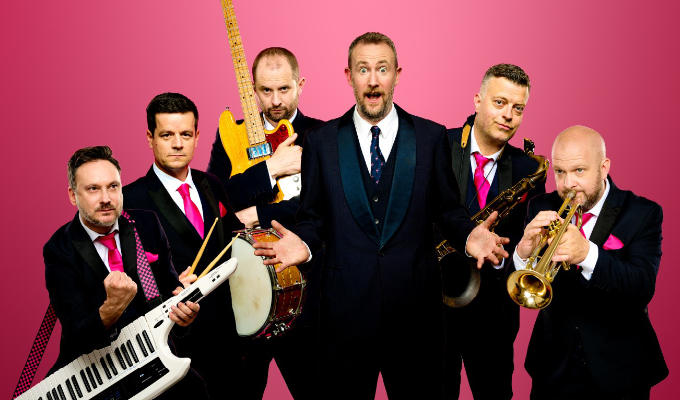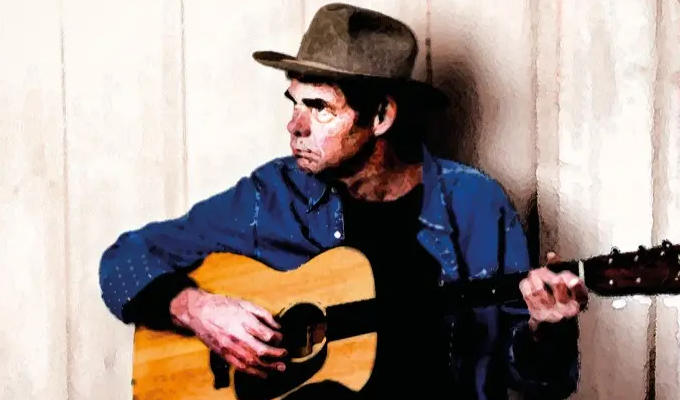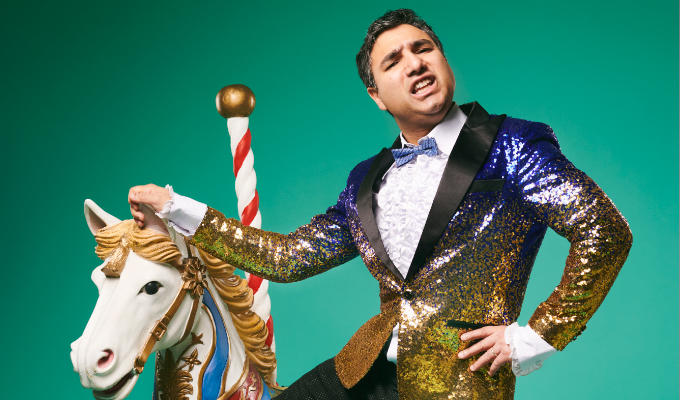Another time, another place
Dean Burnett reviews a DVD of Seventies Geordie comics
The Seventies were a mixed decade for comedy, giving us everything from Fawlty Towers to Bernard Manning, whose success – we can only hope – was very much a product of his time… as well as his place.Today, anyone can stick a clip on YouTube where anyone on Earth can see it. Add this to the dispersal of the tight communities of 30 years ago in favour of more cosmopolitan living and an increasing breakdown in the old cultural and national barriers, and your average comedy audience these days are a far more diverse bunch than those of the Seventies.
I mention this because I’ve just watched a DVD called North East Comedy Classics (£1.99 in a Hyper Value bargain bin), which promised ‘the best of the Newcastle comedy scene of the late Seventies. Since it’s performed by and aimed at people I have no common background with, which took place nearly a decade before I was born, I thought I’d give it a review…
The footage came from an ITV show called What Fettle! – a programme, and indeed a phrase, I have never encountered before, and featured the following acts.
- BOBBY PATTINSON: The DVD is compiled by the well-regarded Pattinson, who is often referred to as ‘The Godfather of North East Comedy’ But while some see him as a classic old-school entertainer in defiance of pretentious modern alternative comedy, others see him as an ignorant old fool who refuses to move with the times and desperately tries to wring the last bit of profit from his usual audience before they all die. Pattinson also writes a brief but surprisingly honest summary of the acts in the DVD inside cover, which is useful.
On stage, he is quite genial, and, as expected, being Geordie does make up much of his set, to the point where he starts discussing how he performs comedy away from Newcastle. It comes across as someone chatting to his friends about a recent gig, rather than delivering a set. A number of the jokes would be hackneyed and basic for a modern comedy club, but this is a different time, and the audience seem generally happy with it.
Maybe it’s a result of fashion at the time, but Pattinson does come across as sleazy. Not in a typical or jokey way, but with his ‘tache, receding hairline and open shirts, he reminds me of dodgy family acquaintance. But this clearly isn’t intentional, and for the most he comes across as very genuine. I imagine it was this, more than his humour or writing, which earned him his acclaim.
- BILLY MARTIN & BOBBY HOOPER (The DIXIELANDERS): The Dixielanders are a double act, but not one that conforms to the standard model of one straight guy and one clown. They start out as such, but don’t stick rigidly to it. Billy Martin, with the shock of white hair and severely big glasses, appears to be the Straight Man (but is surprisingly effeminate, ironically), and Bobby Hooper the affable, gurning idiot, but the act seems to consist largely of two mates discussing things they both feel strongly about, such as generally nostalgic rants about their mothers and outside loos (which they call ‘Nettys’).
Neither one really dominates the other in style or mannerisms; largely they take it in turns to do their piece, and then wait while the other backs it up or starts a new one. As both were stand-ups in their own right, it’s clear that we’re seeing two experienced acts who’ve altered their own sets to accommodate each other, rather than a double act that have perfected their relationship over time.
One unusual aspect of the Dixielanders is the worrying sexual tension between them. I may be imagining things, but often when one is ranting he gets closer and closer to the other, physically emphasising each point, until I would have sworn they were about to kiss. Maybe this says more about my psyche.
- LAMBERT & ROSS: Another, more traditional double act. If Morecambe and Wise showed us how this arrangement can result in comedy gold, Lambert and Ross prove it can give us the comedic equivalent of syphilis. After watching them, I felt used and degraded.
Lambert, another white-haired straight man, reminded me of Norman Lamont reading out the Budget as he has all the comedic charm of a stillborn foetus. Ross the clown, on the other hand, is about as subtle as a brick in the face.
Silly hair, shambolic movements, gratingly ‘wacky’ voices and so many exaggerated facial expressions you want to cave his head in with a shovel. He seems to subscribe to the view that any shitty joke is funny if you do it in a squeaky voice. Maybe he inspired Joe Pasquale?
In the single clip of them, their act takes the form of a spoof hypnotism act, with Ross planted in the audience as the unwilling volunteer. This leads to slapstick, poorly scripted dialogue and constant repetition of ‘punchlines’ that would put Catherine Tate to shame. The humour is so obvious it’s like watching a plane land – you can see it coming a mile off.
And it’s not just that they haven’t dated well; none of the audience at the time was laughing either.
- BOBBY THOMPSON: A big hit in the North East, Thompson, aka the Little Waster, was a master of the mother-in-law joke. And although the humour is clearly dated now, with references to Red Adair, for example, it’s hard not to like Thompson, who comes across as self-depreciating, but resigned to, rather than depressed about, his lot in life. He’s the epitome of the downtrodden working class man of the time. And he’s genuinely funny with it.
Of all the acts on the DVD, Thompson is the one I could see most easily in a modern comedy club, albeit with updated material. Although some aspects of his on-stage persona are deliberate affectations, such as his flat cap and oversized jumper, he blurs the lines between character and genuine personality.
If it is a pure character, he’s clearly gone beyond the call of duty to develop it. He doesn’t look at all well, and was apparently plagued with health problems throughout the Seventies, but this, and his troubles with the taxman became regular features of his set.
Thompson, who died in 1988, appears to have realised that real life stories can be as funny or funnier than corny one-liners, decades before the majority of the comedy world caught up. For that alone he deserves respect.
- ALAN SNELL: According to the DVD cover, Bobby Thompson thought Snell was ripping off his act. He’s got a point. There’s definitely something of a Bill Hicks/Denis Leary correlation between the two acts, but whereas Thompson comes across as a genuine persona, Snell is clearly a caricature. Again with the exaggerated facial expressions, wild hair and over-the-top delivery, subtlety is not what he’s going for.
Snell looks like a knock-off Rab. C. Nesbitt, although he pre-dates him by more than a decade. Indeed, with his scruffy suit and string vest, he may well have inspired the character.
Snell’s set suffers for his exaggerated mannerisms. One-liners that may have been funny are obliterated by shrieked delivery or overwhelmed by facial gymnastics and misplaced, unrealistic outrage. And a number of his jokes appear elsewhere in other people’s sets, lending support to the accusations that at the time it was fine to use other people’s material.
He has some amusing moments, truth be told, but there would be more if the character weren’t so needlessly over-inflated.
- BOBBY KNOXALL: Another act with oversized hair and a whacky costume, but Knoxall gives the impression that he looks this way because that’s what people expect, rather than because he thinks it will make him funnier.
He’s much drier than the other acts who don this garb, relying on tried and tested gags rather than mannerisms or daft voices, and his act seems all the stronger for it. Many of the jokes are classic groan-makers. Many I’ve heard before, and I doubt they were all Knoxall’s own work, but one joke about bread rolls made me laugh out loud.
He’s clearly a jobbing comic of the era, nothing about him in particular stands out but he’s of a good standard, and when he does reference his crazy outfit, it’s with seeming impatience, as if he wants to get it over with and get back to the proper jokes. Kudos to him if this is so.
- PETER MITCHELL: He seems to be a football pundit who wandered onto the wrong place. He clearly just likes talking about the sport, and the jokes seem to be tacked on to justify his being there on stage.
According to his blurb, he is actually a night-lub singer who started doing comedy to increase his earnings. So clearly, comedy isn’t his passion. His set, of friendly chat, does seem more like the banter you get from a pub singer between numbers. There are several big laughs, but as a non-sports fan, references to North East clubs that were doing poorly in the Seventies went way over my head.
He’s likeable enough, and although comedy clearly isn’t his forte the crowd are going along with him. The blurb assures us that he’s an incredible singer – but none of that was shown on the DVD.
- SCARLETT O’HARA: The only female act on the DVD, O’Hara (which I assume isn’t her actual name) is another singer-turned-comic to get the accompanying pay rise.
It’s undeniably harder for women comics these days, God knows what it was like in the Seventies, but O’Hara seems confident in her delivery and totally relaxed on the stage. Too relaxed if anything, as she persistently leans at an odd angle against the mike stand, to the point where I wondered if she had some sort of spinal deformity.
She’s got the stereotypical long flowing dress of a female club singer, but looks like Ruth Madoc on steroids. Her humour concerns the usual (for this DVD) material of growing up in poverty, dominant mothers and other similar topics. And as you’d expect, she labours the problems of being a woman. Men are stupid, kids are a pain, the usual suspects, but done well enough. She’s not the best comic on offer here, but by no means the worst.
- WALTER GEE: Finally, Walter Gee, who, according to the blurb, retired from comedy because of ‘his disgust at today’s comedians and their material forced him into it’. So for any comedians reading this, his retirement is your fault.
Watching him on stage, he comes across as dreadfully condescending. His humour consists of observations on how Geordies are different from everyone else, like people in London (where he’s been, he unsubtly drops in). Apparently, Geordie people carry ferrets wherever they go. That’s the sort of thing he points out. Among these ‘jokes’ are tortured gags based purely on how words are pronounced differently in the regional accents. Who knew?
Gee is a former mime artist who drifted into comedy. So, he’s a mime who couldn’t stop himself from talking. Maybe I was biased due to his melodramatic criticism of contemporary stand-up, but he comes across as thoroughly unlikeable, papering over this with local references to please the audience.
So those are the acts. A mixed bunch, but it’s easy to see common themes. Poverty is the focus of around 90 per cent of the material. Growing up was hard, parents who had to scrimp and save, theft, dole scrounging, idiot relatives, all get a thorough going over. It’s interesting to see how universal these jokes were, and how well received they were by the audience. A sociologist could find a lot of information here. There are also the classic mother-in-law/wife references in spades, which seem hack now.
It’s interesting to notice the audience too. Given the fact that modern comedy is thought of as a young man’s game, there doesn’t seem to be a single person under 40, acts included. As such, nostalgia is used heavily by nearly all the acts, which goes to show that some things never change, given the success of Peter Kay.
It’s very interesting to see how comedy was in the Seventies and how it’s moved on since. Some might say there’s a lot to be learned from watching the old pros. I would disagree; I think we’ve learned all that needs learning, which is why modern comedy is the way it is.
Published: 22 Apr 2008






